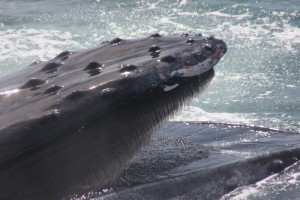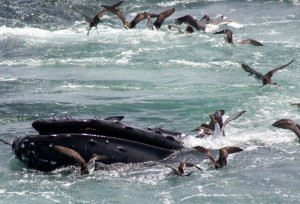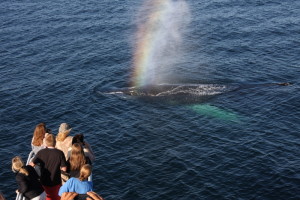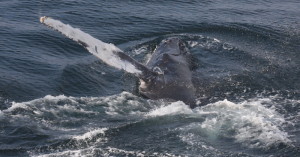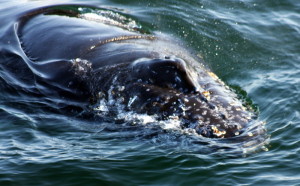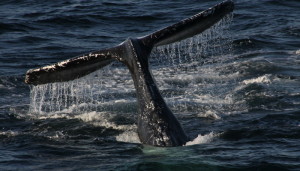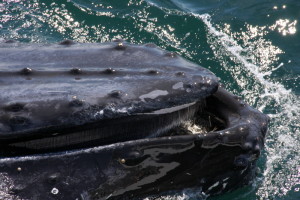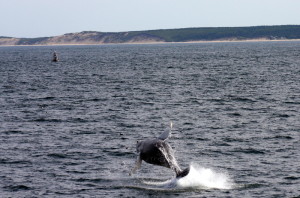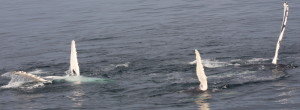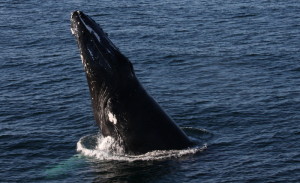Naturalist Notebook –July 7 to July 13
The dolphin fleet naturalists were busy on June 7 as large numbers of humpback whales were sighted throughout the day. In the morning, 20 humpback whales were seen just off of Highland Light (south of Stellwagen Bank). Among those identified were: Elephant, Division, Milkweed, Sushi, Abrasion and calf, Rattan, Perseid, Bolide, Bandit, Draco, Lariat, Stub, Snare and Gunslinger. The whales had located dense schools of sand lance, which is the primary prey for Gulf of Maine humpbacks, which they were feeding on. To catch the fish the whales were employing an array of feeding techniques including blubble clouds and bubble nets! Whales were surfacing through their bubble clouds with wide-open mouths, clearly showing their hundreds of plates of baleen hanging down from the upper jaw.
Thousands of seabirds flocked to the area where the whales were surface feeding. Great shearwaters, sooty shearwaters and wilson’s storm petrels followed the foraging humpback whales in hopes that they would catch a fish or two.
A pronounced change in whale behaviour was noted on the morning July 8 as humpback whales were engaged in long dives lasting for up to 10 minutes. Although humpback whales have the ability to dive for close to a half hour, the average dive time on the feeding grounds is only a few minutes. Naturalists counted 26 individual humpbacks and 12-20 minke whales throughout the day, many of which were going on high-fluking dives, which is usually suggestive of a deep dive.
As the whales dove they revealed their unique fluke print (a pigmentation pattern given a birth), allowing naturalists to identify individuals using the Gulf of Maine humpback whale catalog. Among those identified were: Stub, Aerospace, Abrasion and calf (photo above), Perseid and calf, Entropy, Northstar, Ember and Duckpin. In the afternoon, however, the whales once again began surface feeding and large congregations of seabirds formed.
On July 9 a diverse array of cetacean species and behaviours were observed throughout the day. In the morning the whale watch boats traveled out to the backside of Cape Cod where large aggregations of humpback whales had been sighted for several days in a row. Large groups of shearwaters, wilson’s storm petrels and a few immature terns flew overhead the feeding humpback whales. Groups of 7-8 humpback whales had formed and were engaged in cooperative feeding whereby the whales would dive together below a school of sand lance and circle around the perimeter of their prey releasing columns of bubbles. This kind of coordinated feeding results in a large bubble net that concentrates the school of fish making it easier for the whales to catch their prey and thus improves foraging success.
A large pod (150 individuals) of Atlantic white-sided dolphins was also seen along with record numbers of minke whales (22 individuals) in the afternoon. One naturalist noted that the minke whales were behaving unusually active as they were seen rolling, jumping and charging at the surface.
On the sunset trip the whale watch boat headed to Stellwagen Bank where several humpbacks displayed an array of active behaviours including breaching and flipper slapping. Among the most active was an adult male named Rocker who was first seen in 1991. At one point during the trip, Rocker swam towards the bow of the boat and created a rainbow as he exhaled.
June 10 was a perfect day to be out on the water, with bright skies and clam seas. The morning began with a small pod of Atlantic white-sided dolphins off Race Point. The dolphins appeared to be milling about and a few individuals leapt out of the water. A fin whale was spotted just past the dolphins that was traveling in an almost straight line and three minke whales were sighted as well!
Towards the late morning and early afternoon, another large aggregation of feeding humpback whales were seen off of Highland Light. Naturalists also spotted bluefish, great, sooty and cory shearwaters and wilson’s storm petrels. Two well known adults (Salt and Rune, photo below) were seen feeding cooperatively as they were using bubble clouds to disorient their prey.
In the late afternoon Abrasion was spotted nursing her calf (photo below). Adult females are generally thought to be nursing when their pectoral flippers are extended and their calf is snug against their side (just behind the flippers). Humpback calves will nurse repeatedly throughout the day on their mothers energy rich milk, which is almost the consistency of cottage cheese. Humpback milk is high in fat content (~30-50% fat content) compared to human milk that is ~1% fat. Humpback calves will more than double their body length during their first year of life, which requires a tremendous amount of energy.
The sea conditions were ideal on June 10 with glassy calm waters. Small and temporary groups of humpback whales were observed throughout the day with 22 individuals documented in total. Many of the humpbacks were traveling randomly and going on short dives. This behaviour may suggest that they whales were searching for prey rather than engaging in prey consumption because short dives are usually considered to be explorative in nature whereas repetitive long dives are generally thought to reflect successful foraging. Of course we can never know for certain what the whales are doing sub-surface and only have a few clues available at a time.
In the afternoon the whales began displaying active behaviours such as lob tailing and tail breaching!
Every trip was different on July 12 as resting, feeding and active behaviours were observed throughout the day. In the early morning the whales appears to be resting, as they were spending a considerable amount of time at the surface and were traveling at low speeds. Since whales are voluntary breathers (they need to consciously decide to take a breath) they cannot truly sleep. To rest, the whales are thought to shutdown half their brain, the active half allows them to surface and breath.
In early afternoon, however, the whales began concentrating in large numbers 24-30 individuals and were feeding at the surface. Several whales were using bubble clouds to catch their prey while others were lunging through schools of fish. Many whales had wide-open mouths allowing passengers to see their prey (photo of below).
In the late afternoon the whales began breaching and flipper slapping! Lariat an individual first seen in 2001, put on a tremendous display of active behaviours.
July 13 served as an excellent reminder of the human threats marine mammals face. In the morning the Dolphin Fleet watched 17 humpback whales off Highland Light. High-flyers (long poles with coloured flags), marking fishing gear of various sorts, littered the sea surface as the whales went on fluking dives. One individual dove just in front of a high-flyer, but luckily surfaced unscathed. Unfortunately many whales do become entangled in fishing gear while visiting Cape Cod waters because fisherman and whales are attracted to the same place. Crown, an adult female first seen in 1983, was observed near the fishing gear. When she dove her heavily scared tailstock and flukes appeared, demonstrating the kind of damage whales can incur by way of fishing gear entanglement.
In the afternoon the winds began picking up and so did the whale’s behaviour. While a mile or so from shore, several humpback whales were seen breaching. One individual in particular named Artillery, an individual first seen in 2008, was breaching repetitively. This juvenile humpback conducted several spinning breaches, tail breaches and chin breaches. Just as we were about the leave Artillery, he or she (we don’t know the sex of whale) began flipper slapping!






